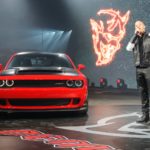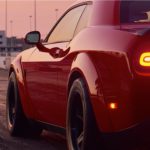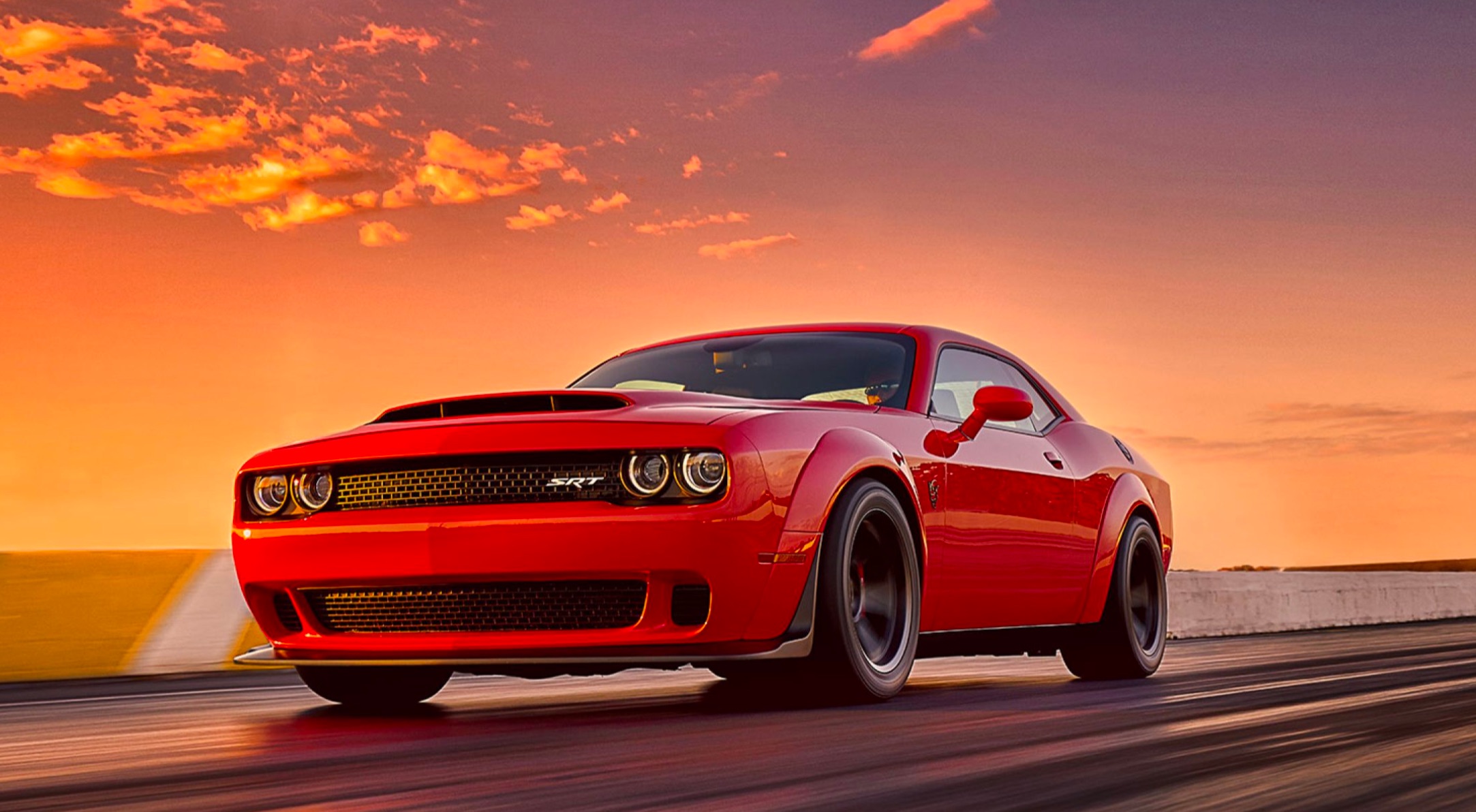
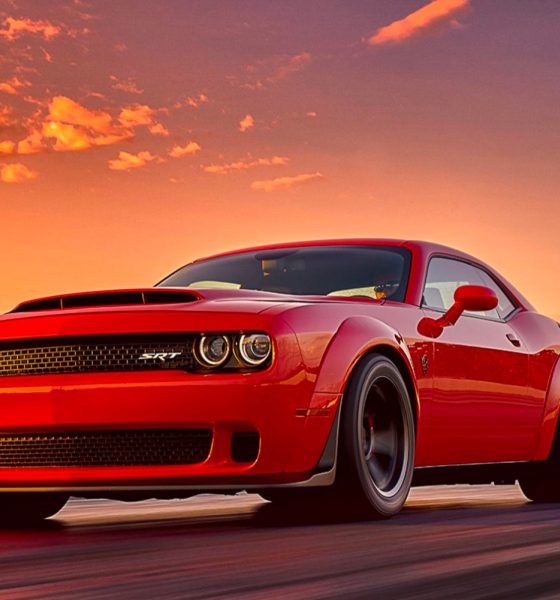
News
Dodge “Demon” looks to dethrone Tesla’s title for “quickest production car” in the world
Tesla sent shock waves through the automotive world in February when Motor Trend crowned the Model S P100D the quickest production car in the world after a 2.28 second run to 60 miles per hour. Do a few hundredths of a second really matter? In the real world, no. But in terms of image, they matter a great deal. Tesla garnered an enormous amount of valuable publicity from the Motor Trend story, and subsequently many 1/4 mile world records being set in a P100D.
Dodge has now responded to the marker laid down by Tesla. Starting this fall, it will offer a special edition of the Dodge Challenger SRT called the “Demon”. Dodge says it can scamper to the magic 60 mile per hour mark in 2.1 seconds, which will allow it to claim the title of quickest production car in the world.
The Demon features a great honking beast of a V8 engine topped with an enormous supercharger and compound intercooling. The Demon engine has 808 horsepower and 717 lb-ft of torque when running on 91 octane pump gas. Put 100+ octane racing fuel in the tank and it’s capable of 840 hp and 770 lb-ft of torque. There’s a big button on the dash the driver can push to change the engine mapping in order to extract maximum power from the racing gas.
The Demon comes from the factory with a driver’s seat and a two speaker stereo. It has almost no sound insulation and no carpeting. The car has smaller brakes and hollow antiroll bars to save weight. If the customer really needs a passenger seat, one can be added for $1 when the order is placed ($1,160 if purchased later). A back seat is available for another $1. A 19-speaker sound system can also be specified.
The Demon is the result of a two year campaign by a small team of 25 Dodge engineers. Compared to the engine in the Hellcat, the Demon’s power plant has 97 new parts including a new crankshaft, new connecting rods, new pistons, a new steel camshaft, and a new valve train. A larger supercharger is fitted and boost pressure is raised from 11.6 psi to 14.5 psi. The engineers also altered the software that controls the eight speed automatic transmission to add a transbrake function. In Drag mode, it allows the engine to build power while the car remains stationary until a flick of the paddle shifter unleashes the beast.
- Credit: Dodge
Photo credit: Motor Trend
“Sometimes you need to ignore the data, disregard the focus groups, and build a car that can define itself,” says Dodge President Tim Kuniskis. “A lot of halos don’t have the greatest business cases.” The halo effect the Hellcat did not go unnoticed in the Dodge board room. While sales of the Hellcat were minimal, orders for the Scat Pack, a special appearance package comprised of stripes, stickers and decals, exploded. 17% of Dodge Challenger buyers now opt for the Scat Pack, an idea that harks back to the muscle car days of the 1960’s.
The Dodge Demon may be a production car, but its numbers will be limited. Only 3,300 will be built — 3,000 for the US market and 300 for Canada. It is definitely intended for serious racers. It can be ordered with The Crate, a box full of go fast goodies that fits in the trunk and includes skinny wheels and tires for the front end on track day. It also contains a special air filter, a tire pressure gauge, and a leather bound manual with tips on how to go drag racing and pages to record data from each run.
There is no doubt the Dodge Demon is an awesome car with brutal acceleration. Its 0-60 run in 2.1 seconds has been verified. But as Motor Trend points out, that feat was achieved at a drag strip, where years of racing have coated the track surface with sticky rubber. The Tesla Model S P100D record was achieved on a public road. The Model S also seats 5 in supreme comfort and is just as happy taking the family to Easter dinner as it is performing banzai runs to 60. The Models S is also a zero emissions vehicle. The Dodge Demon? Not so much.
Still, bragging rights are all about one thing — being quicker than the other guy. Once the Demon hits the streets, we can expect P100D drivers to challenge the new Challenger. Let the Dodge Demon versus Model S drag racing videos begin!

Elon Musk
Tesla CEO Elon Musk announces major update with texting and driving on FSD
“Depending on context of surrounding traffic, yes,” Musk said in regards to FSD v14.2.1 allowing texting and driving.
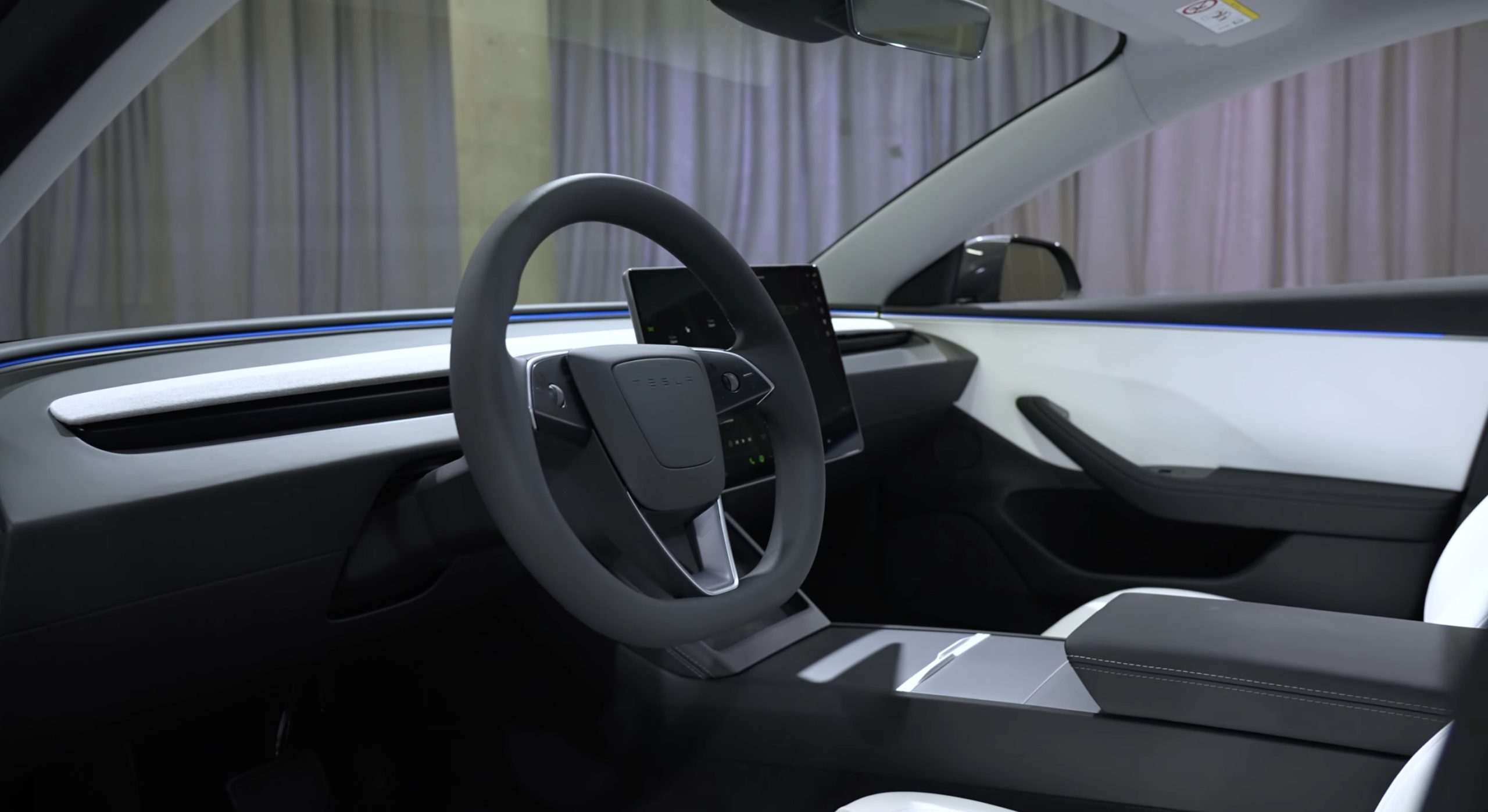
Tesla CEO Elon Musk has announced a major update with texting and driving capabilities on Full Self-Driving v14.2.1, the company’s latest version of the FSD suite.
Tesla Full Self-Driving, even in its most mature and capable versions, is still a Level 2 autonomous driving suite, meaning it requires attention from the vehicle operator.
You cannot sleep, and you should not take attention away from driving; ultimately, you are still solely responsible for what happens with the car.
The vehicles utilize a cabin-facing camera to enable attention monitoring, and if you take your eyes off the road for too long, you will be admonished and advised to pay attention. After five strikes, FSD and Autopilot will be disabled.
However, Musk announced at the Annual Shareholder Meeting in early November that the company would look at the statistics, but it aimed to allow people to text and drive “within the next month or two.”
He said:
“I am confident that, within the next month or two, we’re gonna look at the safety statistics, but we will allow you to text and drive.”
“I am confident that, within the next month or two, we’re gonna look at the safety statistics, but we will allow you to text and drive.”
Does anyone think v14.3 will enable this? pic.twitter.com/N2yn0SK70M
— TESLARATI (@Teslarati) November 23, 2025
Today, Musk confirmed that the current version of Full Self-Driving, which is FSD v14.2.1, does allow for texting and driving “depending on context of surrounding traffic.”
Depending on context of surrounding traffic, yes
— Elon Musk (@elonmusk) December 4, 2025
There are some legitimate questions with this capability, especially as laws in all 50 U.S. states specifically prohibit texting and driving. It will be interesting to see the legality of it, because if a police officer sees you texting, they won’t know that you’re on Full Self-Driving, and you’ll likely be pulled over.
Some states prohibit drivers from even holding a phone when the car is in motion.
It is certainly a move toward unsupervised Full Self-Driving operation, but it is worth noting that Musk’s words state it will only allow the vehicle operator to do it depending on the context of surrounding traffic.
He did not outline any specific conditions that FSD would allow a driver to text and drive.
News
Tesla Semi just got a huge vote of confidence from 300-truck fleet
The confidential meeting marks a major step for the mid-sized carrier in evaluating the electric truck for its regional routes.
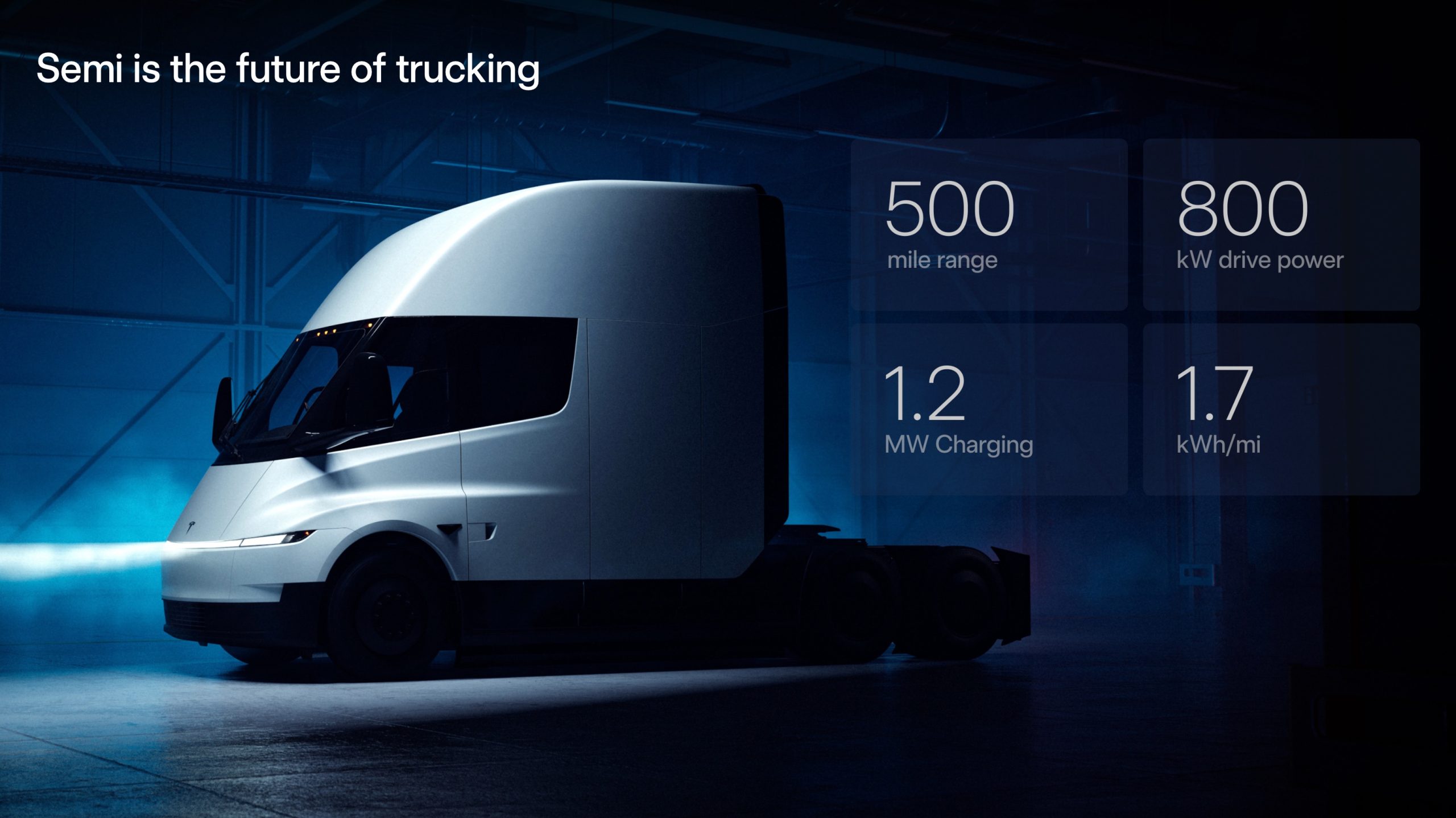
The Tesla Semi is moving closer to broader fleet adoption, with Keller Logistics Group wrapping up a key pre-production planning session with the electric vehicle maker’s team this week.
The confidential meeting marks a major step for the mid-sized carrier in evaluating the electric truck for its regional routes.
Keller’s pre-production Tesla Semi sessions
Keller Logistics Group, a family-owned carrier with over 300 tractors and 1,000 trailers operating in the Midwest and Southeast, completed the session to assess the Tesla Semi’s fit for its operations. The company’s routes typically span 500-600 miles per day, positioning it as an ideal tester for the Semi’s day cab configuration in standard logistics scenarios.
Details remain under mutual NDA, but the meeting reportedly focused on matching the truck to yard, shuttle and regional applications while scrutinizing economics like infrastructure, maintenance and incentives.
What Keller’s executives are saying
CEO Bryan Keller described the approach as methodical. “For us, staying ahead isn’t a headline, it’s a habit. From electrification and yard automation to digital visibility and warehouse technology, our teams are continually pressure-testing what’s next. The Tesla Semi discussion is one more way we evaluate new tools against our standards for safety, uptime, and customer ROI. We don’t chase trends, we pressure-test what works,” Keller said.
Benjamin Pierce, Chief Strategy Officer, echoed these sentiments. “Electrification and next-generation powertrains are part of a much broader transformation. Whether it’s proprietary yard systems like YardLink™, solar and renewable logistics solutions, or real-time vehicle intelligence, Keller’s approach stays the same, test it, prove it, and deploy it only when it strengthens service and total cost for our customers,” Pierce said.
News
Tesla extends FSD Supervised ride-alongs in Europe by three months
Needless to say, it does appear that FSD fever is starting to catch in Europe.

Tesla appears to be doubling down on its European Full Self-Driving (Supervised) push, with the company extending its demo ride-along program by three months until the end of March 2026. The update seems to have been implemented due to overwhelming demand.
Needless to say, it does appear that FSD fever is starting to catch in Europe.
Extended FSD demonstrations
Tesla EU Policy and Business Development Manager Ivan Komušanac shared on LinkedIn that the company is offering ride-along experiences in Germany, France and Italy while working toward FSD (Supervised) approval in Europe.
He noted that this provides a great feedback opportunity from the general public, encouraging participants to record and share their experiences. For those unable to book in December, Komušanac teased more slots as “Christmas presents.”
Tesla watcher Sawyer Merritt highlighted the extension on X, stating that dates now run from December 1, 2025, to March 31, 2026, in multiple cities including Stuttgart-Weinstadt, Frankfurt and Düsseldorf in Germany. This suggests that the FSD ride-along program in Europe has officially been extended until the end of the first quarter of 2026.
Building momentum for European approval
Replies to Merritt’s posts buzzed with excitement, with users like @AuzyMale noting that Cologne and Düsseldorf are already fully booked. This sentiment was echoed by numerous other Tesla enthusiasts on social media. Calls for the program’s expansion to other European territories have also started gaining steam, with some X users suggesting Switzerland and Finland as the next locations for FSD ride-alongs.
Ultimately, the Tesla EU Policy and Business Development Manager’s post aligns with the company’s broader FSD efforts in Europe. As per recent reports, Tesla recently demonstrated FSD’s capabilities for Rome officials. Reporters from media outlets in France and Germany have also published positive reviews of FSD’s capabilities on real-world roads.
